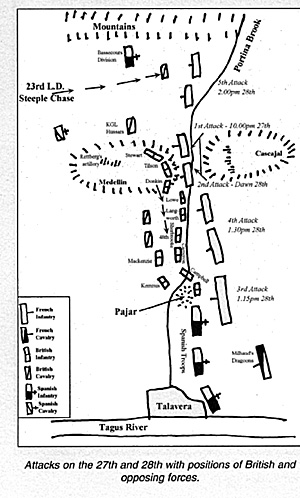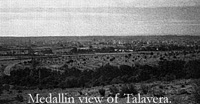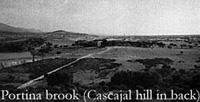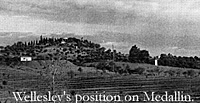
This would be a bad day for Wellesley, one that would find failings in his own army as well as that of Cuesta. He moved two divisions, Sherbrooke's and Mackenzie's, across the Alberche ready to assist Cuesta's retreat over the river towards good defensive positions nearer Talavera.
 Cuesta however managed to achieve something that no other commander, alied or enemy, was ever able to. He got Wellesley on his knees. With a perverse stubborness Cuesta refused to retreat any further and was going to fight with his back to the Alberche. The river was fordable, but wading through a river when advancing is different to retreating pell-mell over it with the enemy snapping at your heels.
Cuesta however managed to achieve something that no other commander, alied or enemy, was ever able to. He got Wellesley on his knees. With a perverse stubborness Cuesta refused to retreat any further and was going to fight with his back to the Alberche. The river was fordable, but wading through a river when advancing is different to retreating pell-mell over it with the enemy snapping at your heels.
With only one bridge over which to retreat if he got into trouble Cuesta was
courting his own destruction. If the Spanish army was routed or badly cut up,
the British would have no choice but to retreat quickly to Portugal. Wellesley
eventually humoured and persuaded him into moving to a more sensible
position west of the river. [9] With
only one bridge over which to retreat if he got into trouble Cuesta was
courting his own destruction. If the Spanish army was routed or badly cut
up the British would have no choice but to retreat quickly to Portugal.
Wellesley eventually humoured and persuaded him into moving to a more
sensible position west of the river. [9]
The two British divisions covered the retreat and then moved back to
the woods around the Casa de Salinas. Sherbrooke's men marched on further west
towards the Portina brook while Mackenzie and a brigade of cavalry acted
as a rear guard in the woods. Two battalions from Donkin's brigade made up
of the 2/87th and the 1/88th were posted to the east of the Casa.
Thinking themselves safe they staked their weapons and tried to get some sleep. The Alberche was, after all, between them and the enemy. At this early stage of the war Wellesley had clearly not yet brought his troops and their commanders up to the standards of professionalism
they would achieve later. Wellesley, trying to get a better view of the area, climbed up a tower at the Casa de Salinas. At the top he had a good view of the area, however he soon spotted a party of French troops directly under the walls of the Casa.
Wellesley and his entourage scampered down the stairs and, jumping onto their horses, made a hasty escape followed by a ragged volley from the enemy soldiers. His capture, wounding or
even death at this point in the war is a sobering thought to contemplate.
Donkin's men, caught unawares, were not so fortunate. Many died as they slept. Others were captured and the whole brigade was disordered for some time. Their sister brigade in Mackenzie's
division, along with five companies of the 5/60th from Donkin's brigade, saved the situation. They were brought forward by Wellesley himself and managed to halt the French, they then covered the retreat to positions north of Talavera. Donkin's men rallied and moved towards the Portina brook. The French lost about 100 men while British casualties were 440. Clearly not a good beginning but the day would get worse before it got better.
The Pajar was converted into a redoubt and other improvised entrenchments were constructed that made the position virtually impregnable. As Napier puts it, 'The front was covered by a convent, by ditches, mud walls, breastworks and felled trees . . . In this position they could not be attacked senously, nor their dispositions even seen, thus one half of the line of battle
was rendered impregnable, yet held by the worst troops.' [10] To bolster the Spanish infantry even more their cavalry were posted behind them.
As evening drew on Wellesley, aided by his staff,
was positioning the Spanish forces, when one of those events took place that lingers in the memory. French cavalry was manoeuvring about 1000 yards in front of the Spanish positions. Some of them fired their pistols, possibly at imaginary rifleman in the bushes. The Spanish reaction to this was to fire off a tremendous and totally ineffectual volley.
Some weeks later Wellesley described what happened. 'Nearly 2,000 ran off... not 100 yards from the place where I was standing, who were neither attacked nor threatened with attack, and who were fnghtened only by the noise of their own fire: they left their arms and their
accoutrements on the ground, their officers went with them; and they and the fugitive cavalry, plundered the baggage of the British army that had been sent to the rear.' [11] . One is forced to wonder where Cuesta was while all this was happening; his coach was seen to be retreating along with the frightened soldiers. He did
however order that the deserting battalions were to be
decimated. Literally 200 were to be shot. Wellesley
tned to save them and managed to get the number
reduced to 40. The sentence on these men was carried
out shortly after the battle.
The ground between the Pajar and the Medellin was
more level and open. All the British troops were west of
the Portina. Placed immediately north of the Spanish was
Campbell's 4th division. It ran in two lines each formed
by a brigade one behind the other. The front brigade,
Campbell's own, held the Pajar hill itself and stretched a
little way northward. Kemmis's brigade was in place just
to their rear and partly behind the Pajar. Sherbrooke's
much larger 1st Division was on their left flank stretching
across the open area and up the southern slopes of the
Medellin hill.
Behind both divisions was Mackenzie's 3rd
Division, less Donkin's brigade, along with the cavalry
brigades of Fane and Cotton. The Medellin was occupied
by Hill's 2nd Division while the Cascajal was left empty.
The valley between the hills would be difficult to cross.
There was a ravine at the bottom formed by the Portina,
whose slopes were rough and steep. The ground north of
the two hills towards the mountains was unoccupied.
According to Wellesley's plan, Hill's men should have
occupied the crest of the Medellin facing the Cascajal.
Unfortunately a staff officer blundered and they were
placed at the western end of the hill.
As their supplies had not arrived the army ate what it had and settled down for a hungry night. They were unaware of the dangerous mistake that had occurred. Due to a staff oversight, and Wellesley being occupied elsewhere with the Spanish, the Medellin, the key to the British position, was guarded only by Donkin's one under-strength brigade. It was therefore open to an
opportune attack by the French.
What of the French? Their plan for holding the
Anglo-Spanish army while Soult came down to
Plasencia, cutting communications with Portugal, was
working. They had checked Cuesta's advance on Madrid.
By blocking the bridges over the Tagus with a small force
at Toledo, they had forced Venegas into time-consuming counter marching towards Aranjuez. Sir Robert Wilson's force was a confusing element in their calculations. Unknown to them
it was a weak force only meant as a feint. They had calculated that the Madrid garrison, though weak, should be strong enough to keep it out of the capital. Joseph would have achieved most by playing a waiting game, which was what Jourdan advised. However the king was worried that Victor might go behind his back to Napoleon, saying he was weak and ineffectual. Victor was all for an attack, he was keen to repeat his success at the battle of Medellin against the Spanish. (The town of Medellin where Cuesta had been ridden over by his own cavalry, not the hill at Talavera). So the king ordered the advance that pushed Cuesta back on the British position
at Talavera, thus re-uniting the two forces.
Now Victor took matters into his own hands. He could see the confusion in the Spanish ranks after their long range volley and subsequent mass retreat. More to the point he could also see that the Medellin was only held by a weak force (Donkin's). Without asking or
consulting Joseph or Jourdan he determined on a night attack to capture the strategic hill. Ruffin's division was ordered across the Portina to dnve the British off the Medellin.
This attack was made by three columns, each
consisting of three battalions. They were to advance in a
co-ordinated pincer movement aiming at the summit of the
hill. Night manoeuvres are notoriously difficult to
co-ordinate and this exercise proved no exception. The
northern-most column got lost and took no part in the
attack. The southern-most column had trouble crossing
the Portina and ended up exchanging long range musket
fire with Langwerth's K.G.L. brigade. The central column,
however, came close to succeeding. It moved down from
the Cascajal into the rough valley between the hills. Here
it encountered great difficulty crossing the ravine so
moved around to the south, where it bumped into Lowe's
brigade, most of whom were asleep without adequate
pickets posted. The 7th K.G.L. battalion suffered heavily
but the 5th was able to form line, deliver a few volleys and
then retired to the south. This encounter caused the
French column to veer northward back up the Medellin.
They passed Donkin's brigade, who did not see them in
the dark, and finally reached the summit of the hill.
Now another hill made his presence felt, this was
Rowland Hill, commanding the 2nd Division. He rode
forward with his brigade-major Fordyce to investigate the
noise and strange movements. His parting comment was that it was probably 'the old Buffs as
usual making some blunder,'[12] the old Buffs being the
3rd Foot. What he rode into was the 9th Leger.
A volley killed Fordyce and senously wounded
Hill's horse, a soldier grabbed the bridle. Hill however
put his spurs to his horse, the poor animal probably
panic-stricken, leapt away leaving the soldier holding
empty air. Hill on returning to his division, ordered
Stewart's brigade up to the crest. They formed into a
column where each company was in a line two deep. The
space between each company was sufficient for the
companies to manoeuvre obliquely into line.
Unfortunately, the lead battalion was made up of detachments. These were units from numerous
under-strength battalions left behind in Portugal when Moore had advanced into Spain the year before. Individually they were too small to stand in the line alone so they had been formed into two Battalions of Detachments. The other was in Kemmis's brigade of the 4th Division. They had little pride in their temporary unit, did not work well together and were repulsed by the
first French battalion they met.
The next British battalion was the 29th, which was
full of unit pride having performed well at both Rolica and
Vimeiro. They advanced in column and pushed two
French battalions off the summit. Then they deployed into
line and met the third enemy battalion that was advancing up the hill in column. They exchanged volleys and forced the French back down the hill.
The 29th with Stewart's other battalion, the 48th, and the remainder of the detachments battalion along with Donkin's brigade now formed a line of defence along the crest of the ridge. Ruffin formed what he could of his division and tried once more to take the hill. Napier described the fighting as 'vehement...in the darkness the opposing flashes of musketry showed with what a resolute spirit the struggle was maintained; the combatants were scarcely 20 yards asunder.' [13]
The French were held and driven off again, many losing their way inthe dark and taken prisoner. The French 2nd division, commanded by Lapisse, supported these attacks but was not heavily engaged. Napier puts the British losses at about 800 men, while those of the French at about 1000; both Weller and Longford put each side's losses at about 300 men. [14]
Meanwhile, Wellesley had ridden up from the Pajar where he had been sorting out the Spanish dispositions. He now corrected the fale dispositions that had encouraged Victor's atack. Donkin's brigade was placed on the southern side of the Medallin, just to thenorth and slightly behind the flank of Lowe's KGL brigade. Tilson's brigade came next, facing the Cascajal and then finally Stewart's brigade. After what must have been a long and frustrating day Wellesley wrapped himself in his cloak and tried to sleep on the Medellin. He was lucky if he got any as
many false alarms and musket flashes disturbed the night. Before dawn, Wellesley had the British in position ready for what that day would bring.
Back to Table of Contents -- First Empire 26 This article appears in MagWeb (Magazine Web) on the Internet World Wide Web. When persuading Cuesta to retreat, Wellesley had promised to position the Spanish troops in the most favourable position. Bearing in mind their poor standards of drill and doubtful manoeuvrability this meant a static, easily defended position. The Spanish were positioned in a
line running north from just east of Talavera town to a hill or large mound called the Pajar de Vergara. The area had numerous small farms with orchards and vineyards. The Portina brook would run behind their line but in the summer it is virtually dry and at this point could be crossed
easily, even by artillery.
When persuading Cuesta to retreat, Wellesley had promised to position the Spanish troops in the most favourable position. Bearing in mind their poor standards of drill and doubtful manoeuvrability this meant a static, easily defended position. The Spanish were positioned in a
line running north from just east of Talavera town to a hill or large mound called the Pajar de Vergara. The area had numerous small farms with orchards and vineyards. The Portina brook would run behind their line but in the summer it is virtually dry and at this point could be crossed
easily, even by artillery.
 Meanwhile the light was fading and with all
this going on Wellesley had little time to supervise the
placing of his own army. The ground between the Pajar
and the mountains had governed Wellesley's planned
dispositions. The Portina brook flowed south from the
mountains, then cut between two hills, the Medellin and
Cascajal and carried on southwards to the Pajar. Here it
flowed around the hill to go behind the Spanish lines.
Meanwhile the light was fading and with all
this going on Wellesley had little time to supervise the
placing of his own army. The ground between the Pajar
and the mountains had governed Wellesley's planned
dispositions. The Portina brook flowed south from the
mountains, then cut between two hills, the Medellin and
Cascajal and carried on southwards to the Pajar. Here it
flowed around the hill to go behind the Spanish lines.
 To compound the error, Hill's division thought their front was covered by the 1st Division's K.G.L. brigades of Lowe and Langwerth. However these two formations were positioned to the south of the Medellin and Lowe at least also thought himself to be in the second line. Donkin's depleted and exhausted brigade, after a hard day's marching and fighting, and lacking orders was placed by Donkin himself on the crest of the Medellin facing the Cascajal.
To compound the error, Hill's division thought their front was covered by the 1st Division's K.G.L. brigades of Lowe and Langwerth. However these two formations were positioned to the south of the Medellin and Lowe at least also thought himself to be in the second line. Donkin's depleted and exhausted brigade, after a hard day's marching and fighting, and lacking orders was placed by Donkin himself on the crest of the Medellin facing the Cascajal.
© Copyright 1996 by First Empire.
Other military history articles and gaming articles are available at http://www.magweb.com